Legal Analysis: Aspects of Contract and Negligence in Business
VerifiedAdded on 2020/01/16
|14
|4316
|179
Report
AI Summary
This report provides a comprehensive overview of contract and negligence within a business context. It begins by defining the essential elements of a valid contract, including offer, acceptance, consideration, and agreement, and differentiates between various contract types like face-to-face, written, and distance selling contracts. The report then delves into contract terms, distinguishing between implied, express, and exclusion terms, and applies these concepts to case scenarios involving contract formation and breach. Furthermore, it explores the distinction between contractual liability and liability in tort, with a focus on negligence, including the application of the Donoghue v Stevenson case and vicarious liability. The analysis extends to the application of negligence elements and potential defenses, as well as a detailed examination of the elements of vicarious liability. The report aims to provide a clear understanding of legal aspects related to business contracts and negligence.
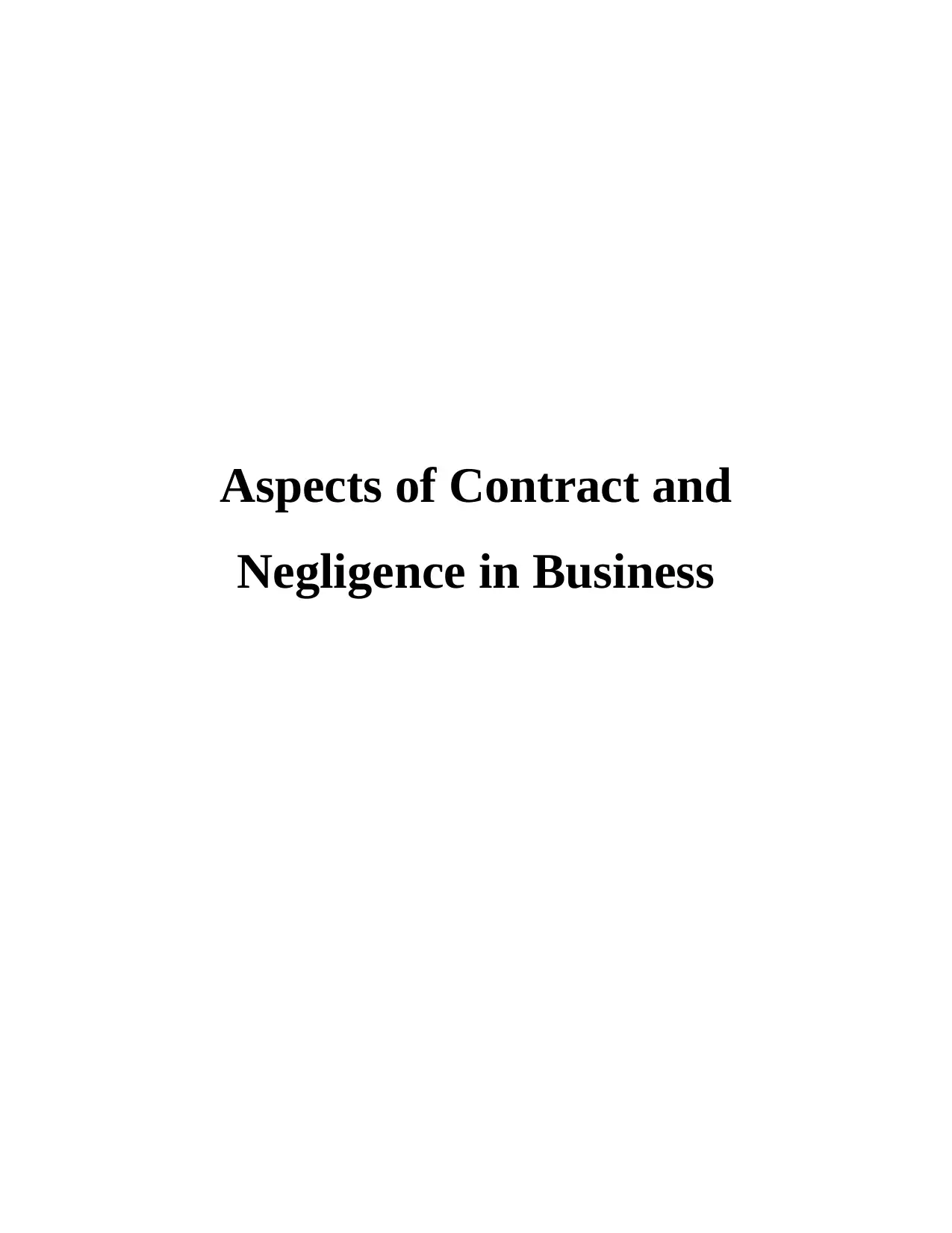
Aspects of Contract and
Negligence in Business
Negligence in Business
Paraphrase This Document
Need a fresh take? Get an instant paraphrase of this document with our AI Paraphraser
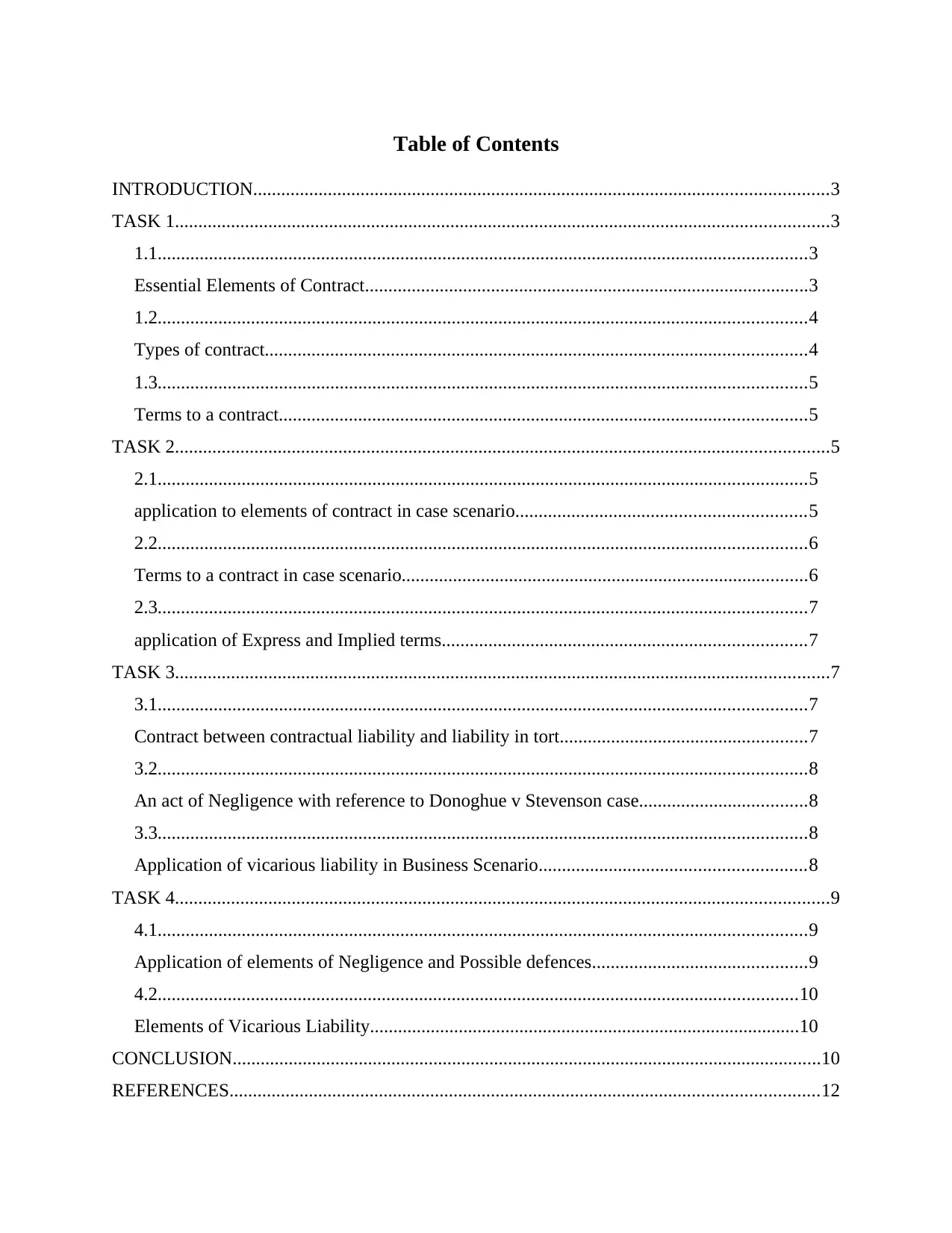
Table of Contents
INTRODUCTION...........................................................................................................................3
TASK 1............................................................................................................................................3
1.1...........................................................................................................................................3
Essential Elements of Contract...............................................................................................3
1.2...........................................................................................................................................4
Types of contract....................................................................................................................4
1.3...........................................................................................................................................5
Terms to a contract.................................................................................................................5
TASK 2............................................................................................................................................5
2.1...........................................................................................................................................5
application to elements of contract in case scenario..............................................................5
2.2...........................................................................................................................................6
Terms to a contract in case scenario.......................................................................................6
2.3...........................................................................................................................................7
application of Express and Implied terms..............................................................................7
TASK 3............................................................................................................................................7
3.1...........................................................................................................................................7
Contract between contractual liability and liability in tort.....................................................7
3.2...........................................................................................................................................8
An act of Negligence with reference to Donoghue v Stevenson case....................................8
3.3...........................................................................................................................................8
Application of vicarious liability in Business Scenario.........................................................8
TASK 4............................................................................................................................................9
4.1...........................................................................................................................................9
Application of elements of Negligence and Possible defences..............................................9
4.2.........................................................................................................................................10
Elements of Vicarious Liability............................................................................................10
CONCLUSION..............................................................................................................................10
REFERENCES..............................................................................................................................12
INTRODUCTION...........................................................................................................................3
TASK 1............................................................................................................................................3
1.1...........................................................................................................................................3
Essential Elements of Contract...............................................................................................3
1.2...........................................................................................................................................4
Types of contract....................................................................................................................4
1.3...........................................................................................................................................5
Terms to a contract.................................................................................................................5
TASK 2............................................................................................................................................5
2.1...........................................................................................................................................5
application to elements of contract in case scenario..............................................................5
2.2...........................................................................................................................................6
Terms to a contract in case scenario.......................................................................................6
2.3...........................................................................................................................................7
application of Express and Implied terms..............................................................................7
TASK 3............................................................................................................................................7
3.1...........................................................................................................................................7
Contract between contractual liability and liability in tort.....................................................7
3.2...........................................................................................................................................8
An act of Negligence with reference to Donoghue v Stevenson case....................................8
3.3...........................................................................................................................................8
Application of vicarious liability in Business Scenario.........................................................8
TASK 4............................................................................................................................................9
4.1...........................................................................................................................................9
Application of elements of Negligence and Possible defences..............................................9
4.2.........................................................................................................................................10
Elements of Vicarious Liability............................................................................................10
CONCLUSION..............................................................................................................................10
REFERENCES..............................................................................................................................12
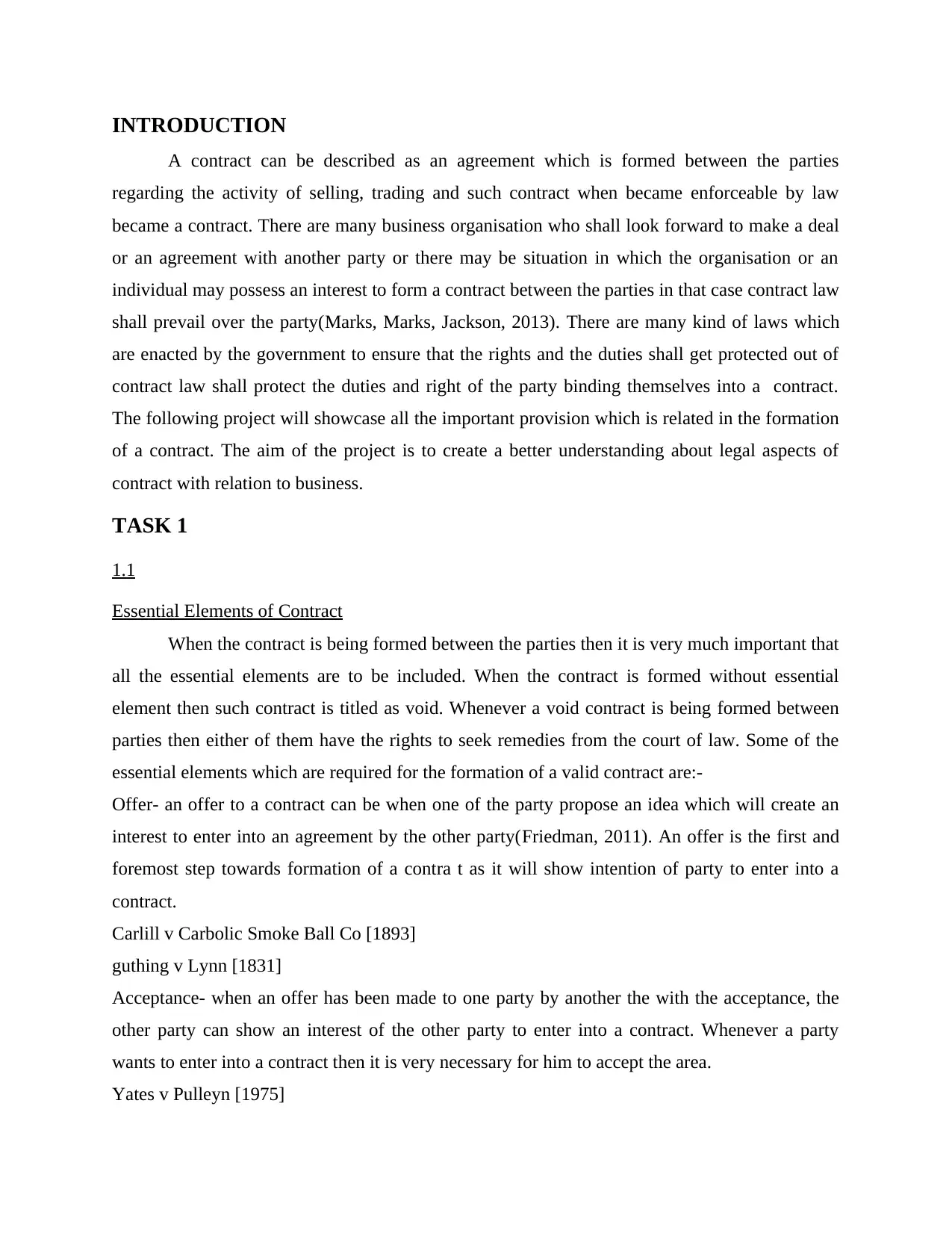
INTRODUCTION
A contract can be described as an agreement which is formed between the parties
regarding the activity of selling, trading and such contract when became enforceable by law
became a contract. There are many business organisation who shall look forward to make a deal
or an agreement with another party or there may be situation in which the organisation or an
individual may possess an interest to form a contract between the parties in that case contract law
shall prevail over the party(Marks, Marks, Jackson, 2013). There are many kind of laws which
are enacted by the government to ensure that the rights and the duties shall get protected out of
contract law shall protect the duties and right of the party binding themselves into a contract.
The following project will showcase all the important provision which is related in the formation
of a contract. The aim of the project is to create a better understanding about legal aspects of
contract with relation to business.
TASK 1
1.1
Essential Elements of Contract
When the contract is being formed between the parties then it is very much important that
all the essential elements are to be included. When the contract is formed without essential
element then such contract is titled as void. Whenever a void contract is being formed between
parties then either of them have the rights to seek remedies from the court of law. Some of the
essential elements which are required for the formation of a valid contract are:-
Offer- an offer to a contract can be when one of the party propose an idea which will create an
interest to enter into an agreement by the other party(Friedman, 2011). An offer is the first and
foremost step towards formation of a contra t as it will show intention of party to enter into a
contract.
Carlill v Carbolic Smoke Ball Co [1893]
guthing v Lynn [1831]
Acceptance- when an offer has been made to one party by another the with the acceptance, the
other party can show an interest of the other party to enter into a contract. Whenever a party
wants to enter into a contract then it is very necessary for him to accept the area.
Yates v Pulleyn [1975]
A contract can be described as an agreement which is formed between the parties
regarding the activity of selling, trading and such contract when became enforceable by law
became a contract. There are many business organisation who shall look forward to make a deal
or an agreement with another party or there may be situation in which the organisation or an
individual may possess an interest to form a contract between the parties in that case contract law
shall prevail over the party(Marks, Marks, Jackson, 2013). There are many kind of laws which
are enacted by the government to ensure that the rights and the duties shall get protected out of
contract law shall protect the duties and right of the party binding themselves into a contract.
The following project will showcase all the important provision which is related in the formation
of a contract. The aim of the project is to create a better understanding about legal aspects of
contract with relation to business.
TASK 1
1.1
Essential Elements of Contract
When the contract is being formed between the parties then it is very much important that
all the essential elements are to be included. When the contract is formed without essential
element then such contract is titled as void. Whenever a void contract is being formed between
parties then either of them have the rights to seek remedies from the court of law. Some of the
essential elements which are required for the formation of a valid contract are:-
Offer- an offer to a contract can be when one of the party propose an idea which will create an
interest to enter into an agreement by the other party(Friedman, 2011). An offer is the first and
foremost step towards formation of a contra t as it will show intention of party to enter into a
contract.
Carlill v Carbolic Smoke Ball Co [1893]
guthing v Lynn [1831]
Acceptance- when an offer has been made to one party by another the with the acceptance, the
other party can show an interest of the other party to enter into a contract. Whenever a party
wants to enter into a contract then it is very necessary for him to accept the area.
Yates v Pulleyn [1975]
⊘ This is a preview!⊘
Do you want full access?
Subscribe today to unlock all pages.

Trusted by 1+ million students worldwide
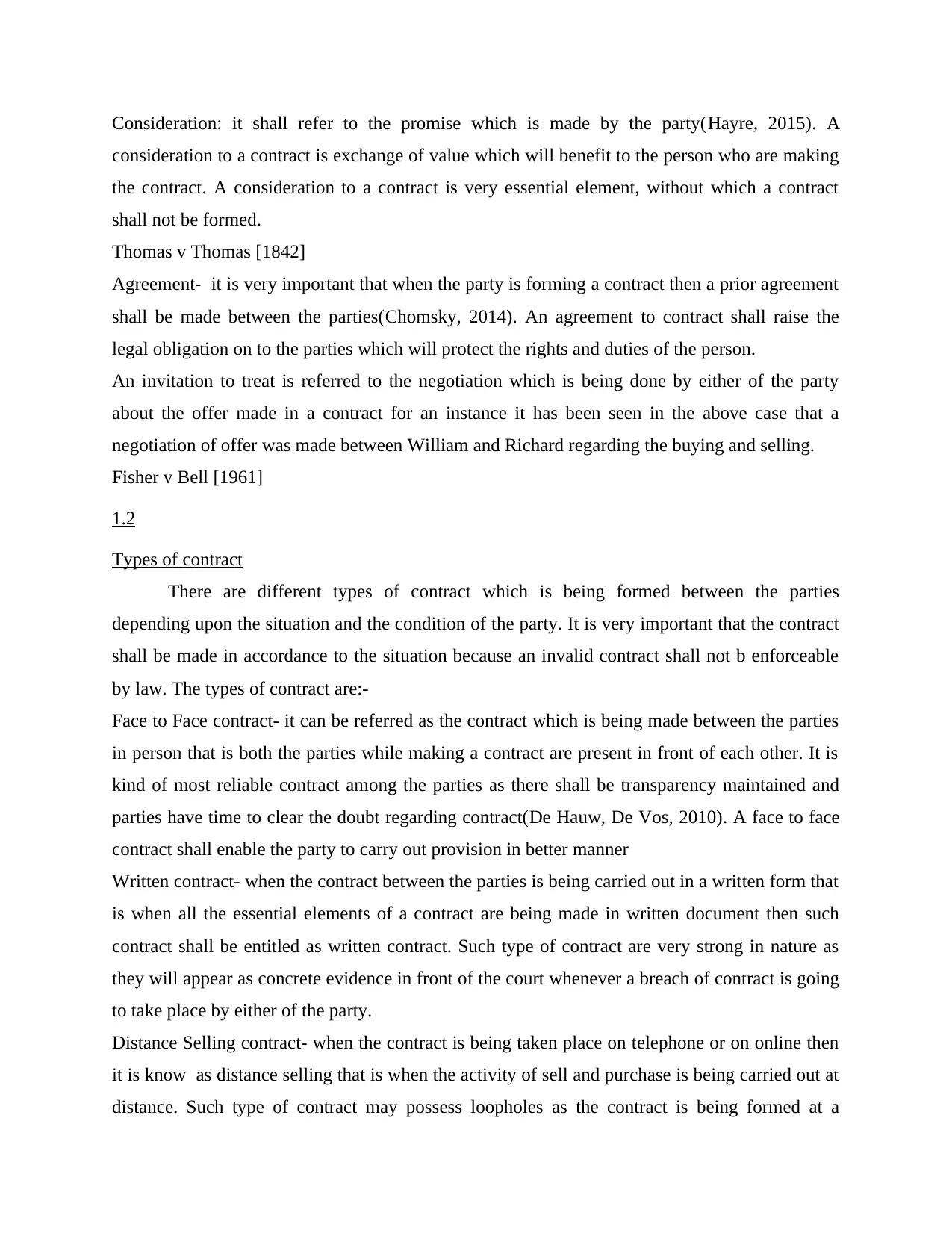
Consideration: it shall refer to the promise which is made by the party(Hayre, 2015). A
consideration to a contract is exchange of value which will benefit to the person who are making
the contract. A consideration to a contract is very essential element, without which a contract
shall not be formed.
Thomas v Thomas [1842]
Agreement- it is very important that when the party is forming a contract then a prior agreement
shall be made between the parties(Chomsky, 2014). An agreement to contract shall raise the
legal obligation on to the parties which will protect the rights and duties of the person.
An invitation to treat is referred to the negotiation which is being done by either of the party
about the offer made in a contract for an instance it has been seen in the above case that a
negotiation of offer was made between William and Richard regarding the buying and selling.
Fisher v Bell [1961]
1.2
Types of contract
There are different types of contract which is being formed between the parties
depending upon the situation and the condition of the party. It is very important that the contract
shall be made in accordance to the situation because an invalid contract shall not b enforceable
by law. The types of contract are:-
Face to Face contract- it can be referred as the contract which is being made between the parties
in person that is both the parties while making a contract are present in front of each other. It is
kind of most reliable contract among the parties as there shall be transparency maintained and
parties have time to clear the doubt regarding contract(De Hauw, De Vos, 2010). A face to face
contract shall enable the party to carry out provision in better manner
Written contract- when the contract between the parties is being carried out in a written form that
is when all the essential elements of a contract are being made in written document then such
contract shall be entitled as written contract. Such type of contract are very strong in nature as
they will appear as concrete evidence in front of the court whenever a breach of contract is going
to take place by either of the party.
Distance Selling contract- when the contract is being taken place on telephone or on online then
it is know as distance selling that is when the activity of sell and purchase is being carried out at
distance. Such type of contract may possess loopholes as the contract is being formed at a
consideration to a contract is exchange of value which will benefit to the person who are making
the contract. A consideration to a contract is very essential element, without which a contract
shall not be formed.
Thomas v Thomas [1842]
Agreement- it is very important that when the party is forming a contract then a prior agreement
shall be made between the parties(Chomsky, 2014). An agreement to contract shall raise the
legal obligation on to the parties which will protect the rights and duties of the person.
An invitation to treat is referred to the negotiation which is being done by either of the party
about the offer made in a contract for an instance it has been seen in the above case that a
negotiation of offer was made between William and Richard regarding the buying and selling.
Fisher v Bell [1961]
1.2
Types of contract
There are different types of contract which is being formed between the parties
depending upon the situation and the condition of the party. It is very important that the contract
shall be made in accordance to the situation because an invalid contract shall not b enforceable
by law. The types of contract are:-
Face to Face contract- it can be referred as the contract which is being made between the parties
in person that is both the parties while making a contract are present in front of each other. It is
kind of most reliable contract among the parties as there shall be transparency maintained and
parties have time to clear the doubt regarding contract(De Hauw, De Vos, 2010). A face to face
contract shall enable the party to carry out provision in better manner
Written contract- when the contract between the parties is being carried out in a written form that
is when all the essential elements of a contract are being made in written document then such
contract shall be entitled as written contract. Such type of contract are very strong in nature as
they will appear as concrete evidence in front of the court whenever a breach of contract is going
to take place by either of the party.
Distance Selling contract- when the contract is being taken place on telephone or on online then
it is know as distance selling that is when the activity of sell and purchase is being carried out at
distance. Such type of contract may possess loopholes as the contract is being formed at a
Paraphrase This Document
Need a fresh take? Get an instant paraphrase of this document with our AI Paraphraser
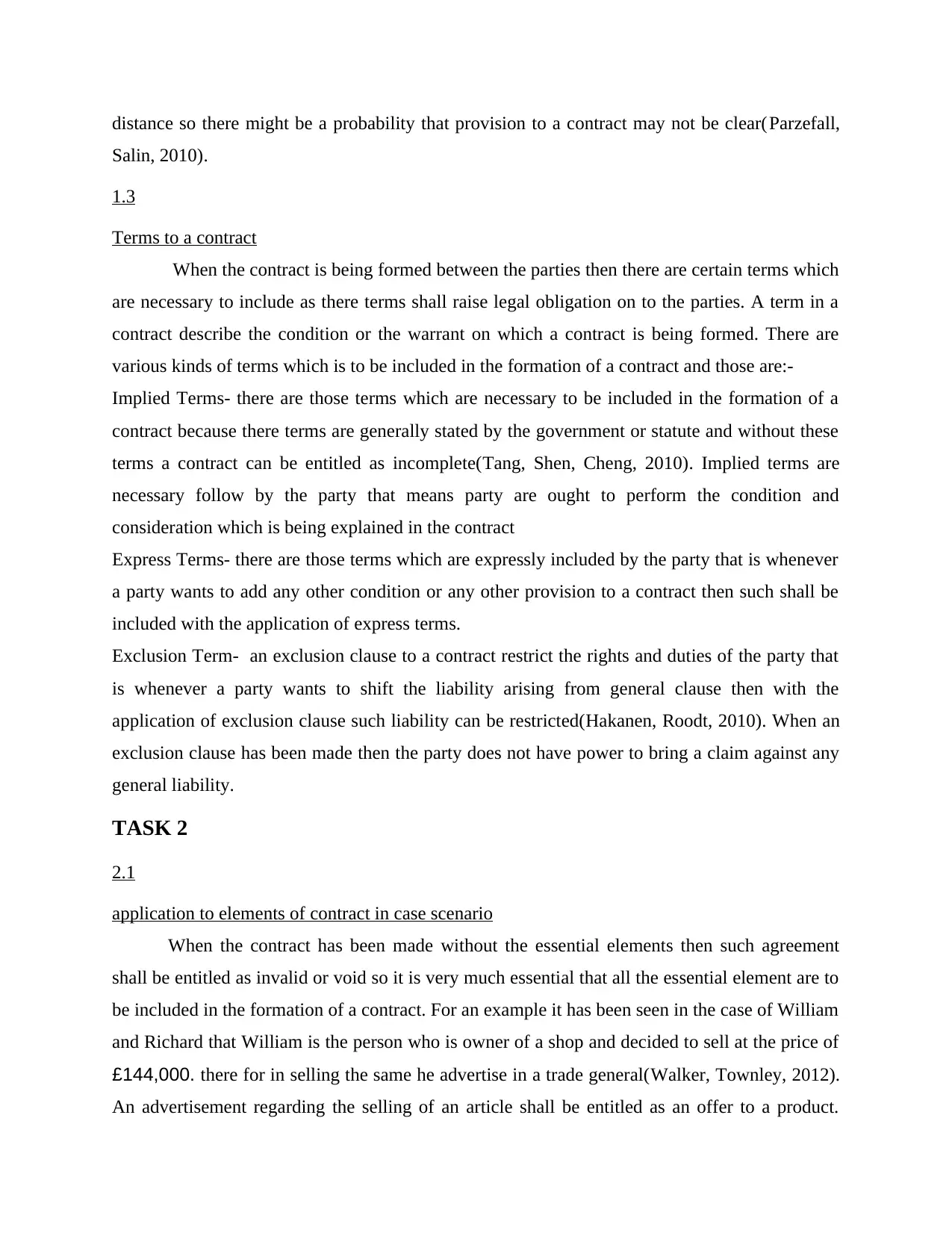
distance so there might be a probability that provision to a contract may not be clear(Parzefall,
Salin, 2010).
1.3
Terms to a contract
When the contract is being formed between the parties then there are certain terms which
are necessary to include as there terms shall raise legal obligation on to the parties. A term in a
contract describe the condition or the warrant on which a contract is being formed. There are
various kinds of terms which is to be included in the formation of a contract and those are:-
Implied Terms- there are those terms which are necessary to be included in the formation of a
contract because there terms are generally stated by the government or statute and without these
terms a contract can be entitled as incomplete(Tang, Shen, Cheng, 2010). Implied terms are
necessary follow by the party that means party are ought to perform the condition and
consideration which is being explained in the contract
Express Terms- there are those terms which are expressly included by the party that is whenever
a party wants to add any other condition or any other provision to a contract then such shall be
included with the application of express terms.
Exclusion Term- an exclusion clause to a contract restrict the rights and duties of the party that
is whenever a party wants to shift the liability arising from general clause then with the
application of exclusion clause such liability can be restricted(Hakanen, Roodt, 2010). When an
exclusion clause has been made then the party does not have power to bring a claim against any
general liability.
TASK 2
2.1
application to elements of contract in case scenario
When the contract has been made without the essential elements then such agreement
shall be entitled as invalid or void so it is very much essential that all the essential element are to
be included in the formation of a contract. For an example it has been seen in the case of William
and Richard that William is the person who is owner of a shop and decided to sell at the price of
£144,000. there for in selling the same he advertise in a trade general(Walker, Townley, 2012).
An advertisement regarding the selling of an article shall be entitled as an offer to a product.
Salin, 2010).
1.3
Terms to a contract
When the contract is being formed between the parties then there are certain terms which
are necessary to include as there terms shall raise legal obligation on to the parties. A term in a
contract describe the condition or the warrant on which a contract is being formed. There are
various kinds of terms which is to be included in the formation of a contract and those are:-
Implied Terms- there are those terms which are necessary to be included in the formation of a
contract because there terms are generally stated by the government or statute and without these
terms a contract can be entitled as incomplete(Tang, Shen, Cheng, 2010). Implied terms are
necessary follow by the party that means party are ought to perform the condition and
consideration which is being explained in the contract
Express Terms- there are those terms which are expressly included by the party that is whenever
a party wants to add any other condition or any other provision to a contract then such shall be
included with the application of express terms.
Exclusion Term- an exclusion clause to a contract restrict the rights and duties of the party that
is whenever a party wants to shift the liability arising from general clause then with the
application of exclusion clause such liability can be restricted(Hakanen, Roodt, 2010). When an
exclusion clause has been made then the party does not have power to bring a claim against any
general liability.
TASK 2
2.1
application to elements of contract in case scenario
When the contract has been made without the essential elements then such agreement
shall be entitled as invalid or void so it is very much essential that all the essential element are to
be included in the formation of a contract. For an example it has been seen in the case of William
and Richard that William is the person who is owner of a shop and decided to sell at the price of
£144,000. there for in selling the same he advertise in a trade general(Walker, Townley, 2012).
An advertisement regarding the selling of an article shall be entitled as an offer to a product.
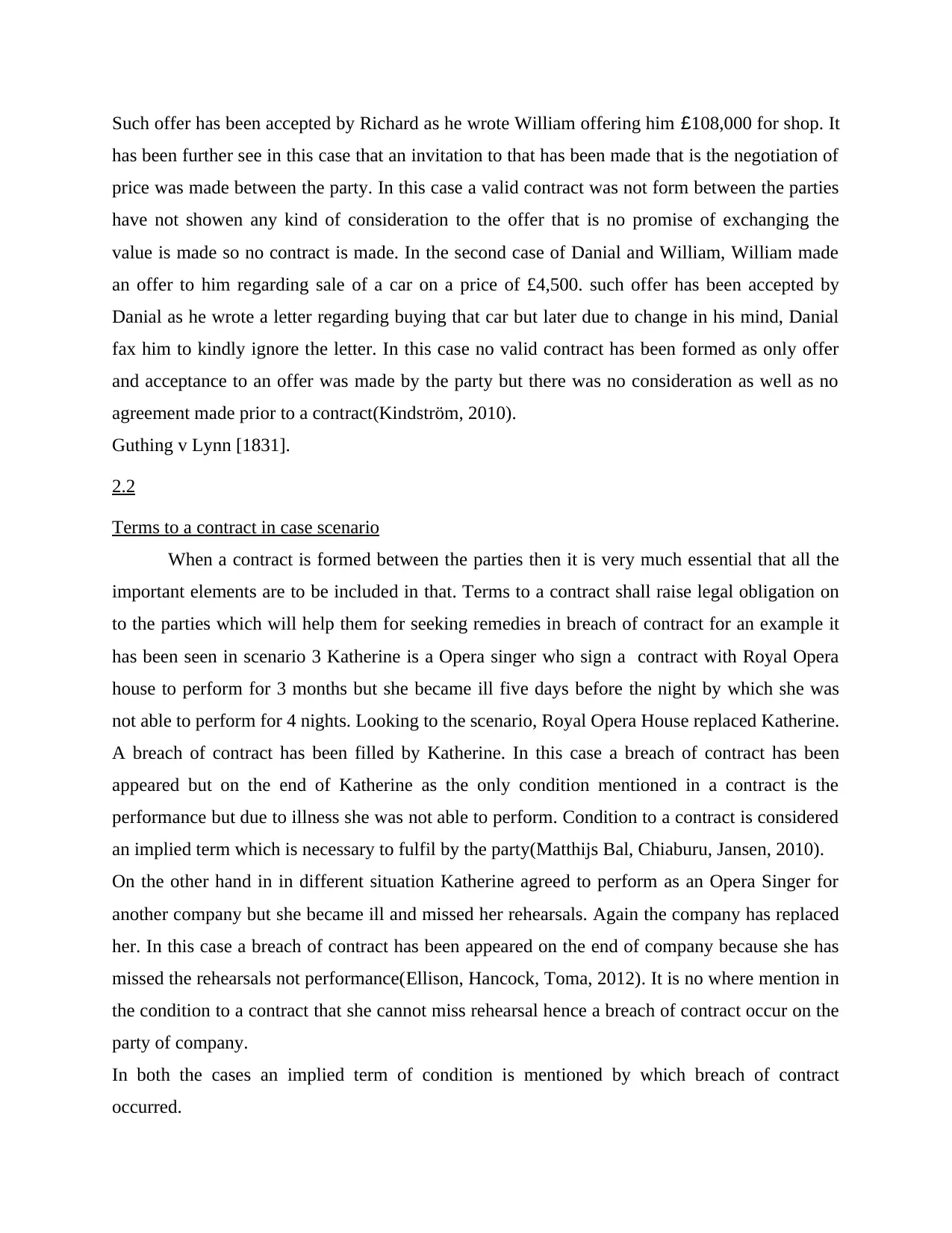
Such offer has been accepted by Richard as he wrote William offering him £108,000 for shop. It
has been further see in this case that an invitation to that has been made that is the negotiation of
price was made between the party. In this case a valid contract was not form between the parties
have not showen any kind of consideration to the offer that is no promise of exchanging the
value is made so no contract is made. In the second case of Danial and William, William made
an offer to him regarding sale of a car on a price of £4,500. such offer has been accepted by
Danial as he wrote a letter regarding buying that car but later due to change in his mind, Danial
fax him to kindly ignore the letter. In this case no valid contract has been formed as only offer
and acceptance to an offer was made by the party but there was no consideration as well as no
agreement made prior to a contract(Kindström, 2010).
Guthing v Lynn [1831].
2.2
Terms to a contract in case scenario
When a contract is formed between the parties then it is very much essential that all the
important elements are to be included in that. Terms to a contract shall raise legal obligation on
to the parties which will help them for seeking remedies in breach of contract for an example it
has been seen in scenario 3 Katherine is a Opera singer who sign a contract with Royal Opera
house to perform for 3 months but she became ill five days before the night by which she was
not able to perform for 4 nights. Looking to the scenario, Royal Opera House replaced Katherine.
A breach of contract has been filled by Katherine. In this case a breach of contract has been
appeared but on the end of Katherine as the only condition mentioned in a contract is the
performance but due to illness she was not able to perform. Condition to a contract is considered
an implied term which is necessary to fulfil by the party(Matthijs Bal, Chiaburu, Jansen, 2010).
On the other hand in in different situation Katherine agreed to perform as an Opera Singer for
another company but she became ill and missed her rehearsals. Again the company has replaced
her. In this case a breach of contract has been appeared on the end of company because she has
missed the rehearsals not performance(Ellison, Hancock, Toma, 2012). It is no where mention in
the condition to a contract that she cannot miss rehearsal hence a breach of contract occur on the
party of company.
In both the cases an implied term of condition is mentioned by which breach of contract
occurred.
has been further see in this case that an invitation to that has been made that is the negotiation of
price was made between the party. In this case a valid contract was not form between the parties
have not showen any kind of consideration to the offer that is no promise of exchanging the
value is made so no contract is made. In the second case of Danial and William, William made
an offer to him regarding sale of a car on a price of £4,500. such offer has been accepted by
Danial as he wrote a letter regarding buying that car but later due to change in his mind, Danial
fax him to kindly ignore the letter. In this case no valid contract has been formed as only offer
and acceptance to an offer was made by the party but there was no consideration as well as no
agreement made prior to a contract(Kindström, 2010).
Guthing v Lynn [1831].
2.2
Terms to a contract in case scenario
When a contract is formed between the parties then it is very much essential that all the
important elements are to be included in that. Terms to a contract shall raise legal obligation on
to the parties which will help them for seeking remedies in breach of contract for an example it
has been seen in scenario 3 Katherine is a Opera singer who sign a contract with Royal Opera
house to perform for 3 months but she became ill five days before the night by which she was
not able to perform for 4 nights. Looking to the scenario, Royal Opera House replaced Katherine.
A breach of contract has been filled by Katherine. In this case a breach of contract has been
appeared but on the end of Katherine as the only condition mentioned in a contract is the
performance but due to illness she was not able to perform. Condition to a contract is considered
an implied term which is necessary to fulfil by the party(Matthijs Bal, Chiaburu, Jansen, 2010).
On the other hand in in different situation Katherine agreed to perform as an Opera Singer for
another company but she became ill and missed her rehearsals. Again the company has replaced
her. In this case a breach of contract has been appeared on the end of company because she has
missed the rehearsals not performance(Ellison, Hancock, Toma, 2012). It is no where mention in
the condition to a contract that she cannot miss rehearsal hence a breach of contract occur on the
party of company.
In both the cases an implied term of condition is mentioned by which breach of contract
occurred.
⊘ This is a preview!⊘
Do you want full access?
Subscribe today to unlock all pages.

Trusted by 1+ million students worldwide
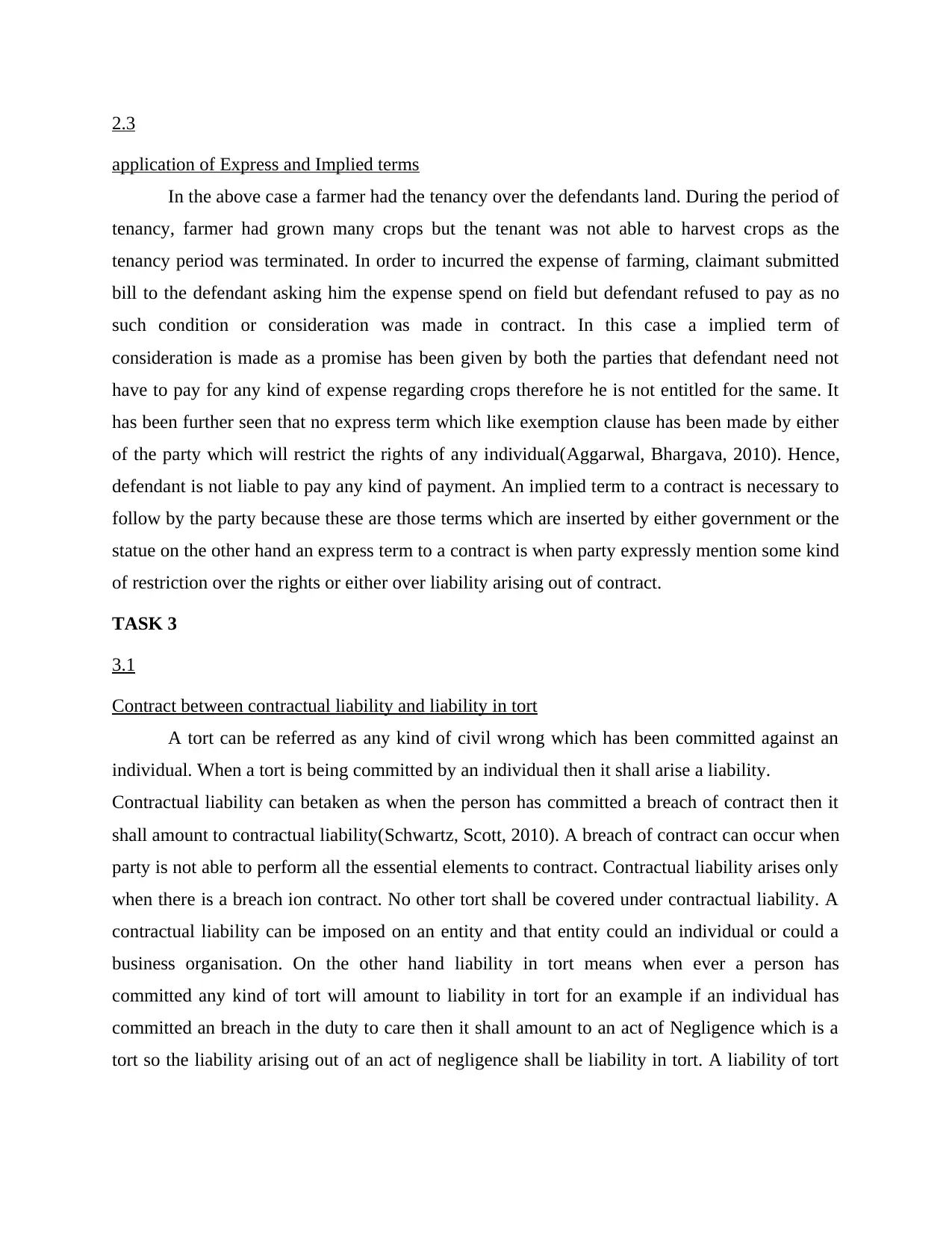
2.3
application of Express and Implied terms
In the above case a farmer had the tenancy over the defendants land. During the period of
tenancy, farmer had grown many crops but the tenant was not able to harvest crops as the
tenancy period was terminated. In order to incurred the expense of farming, claimant submitted
bill to the defendant asking him the expense spend on field but defendant refused to pay as no
such condition or consideration was made in contract. In this case a implied term of
consideration is made as a promise has been given by both the parties that defendant need not
have to pay for any kind of expense regarding crops therefore he is not entitled for the same. It
has been further seen that no express term which like exemption clause has been made by either
of the party which will restrict the rights of any individual(Aggarwal, Bhargava, 2010). Hence,
defendant is not liable to pay any kind of payment. An implied term to a contract is necessary to
follow by the party because these are those terms which are inserted by either government or the
statue on the other hand an express term to a contract is when party expressly mention some kind
of restriction over the rights or either over liability arising out of contract.
TASK 3
3.1
Contract between contractual liability and liability in tort
A tort can be referred as any kind of civil wrong which has been committed against an
individual. When a tort is being committed by an individual then it shall arise a liability.
Contractual liability can betaken as when the person has committed a breach of contract then it
shall amount to contractual liability(Schwartz, Scott, 2010). A breach of contract can occur when
party is not able to perform all the essential elements to contract. Contractual liability arises only
when there is a breach ion contract. No other tort shall be covered under contractual liability. A
contractual liability can be imposed on an entity and that entity could an individual or could a
business organisation. On the other hand liability in tort means when ever a person has
committed any kind of tort will amount to liability in tort for an example if an individual has
committed an breach in the duty to care then it shall amount to an act of Negligence which is a
tort so the liability arising out of an act of negligence shall be liability in tort. A liability of tort
application of Express and Implied terms
In the above case a farmer had the tenancy over the defendants land. During the period of
tenancy, farmer had grown many crops but the tenant was not able to harvest crops as the
tenancy period was terminated. In order to incurred the expense of farming, claimant submitted
bill to the defendant asking him the expense spend on field but defendant refused to pay as no
such condition or consideration was made in contract. In this case a implied term of
consideration is made as a promise has been given by both the parties that defendant need not
have to pay for any kind of expense regarding crops therefore he is not entitled for the same. It
has been further seen that no express term which like exemption clause has been made by either
of the party which will restrict the rights of any individual(Aggarwal, Bhargava, 2010). Hence,
defendant is not liable to pay any kind of payment. An implied term to a contract is necessary to
follow by the party because these are those terms which are inserted by either government or the
statue on the other hand an express term to a contract is when party expressly mention some kind
of restriction over the rights or either over liability arising out of contract.
TASK 3
3.1
Contract between contractual liability and liability in tort
A tort can be referred as any kind of civil wrong which has been committed against an
individual. When a tort is being committed by an individual then it shall arise a liability.
Contractual liability can betaken as when the person has committed a breach of contract then it
shall amount to contractual liability(Schwartz, Scott, 2010). A breach of contract can occur when
party is not able to perform all the essential elements to contract. Contractual liability arises only
when there is a breach ion contract. No other tort shall be covered under contractual liability. A
contractual liability can be imposed on an entity and that entity could an individual or could a
business organisation. On the other hand liability in tort means when ever a person has
committed any kind of tort will amount to liability in tort for an example if an individual has
committed an breach in the duty to care then it shall amount to an act of Negligence which is a
tort so the liability arising out of an act of negligence shall be liability in tort. A liability of tort
Paraphrase This Document
Need a fresh take? Get an instant paraphrase of this document with our AI Paraphraser
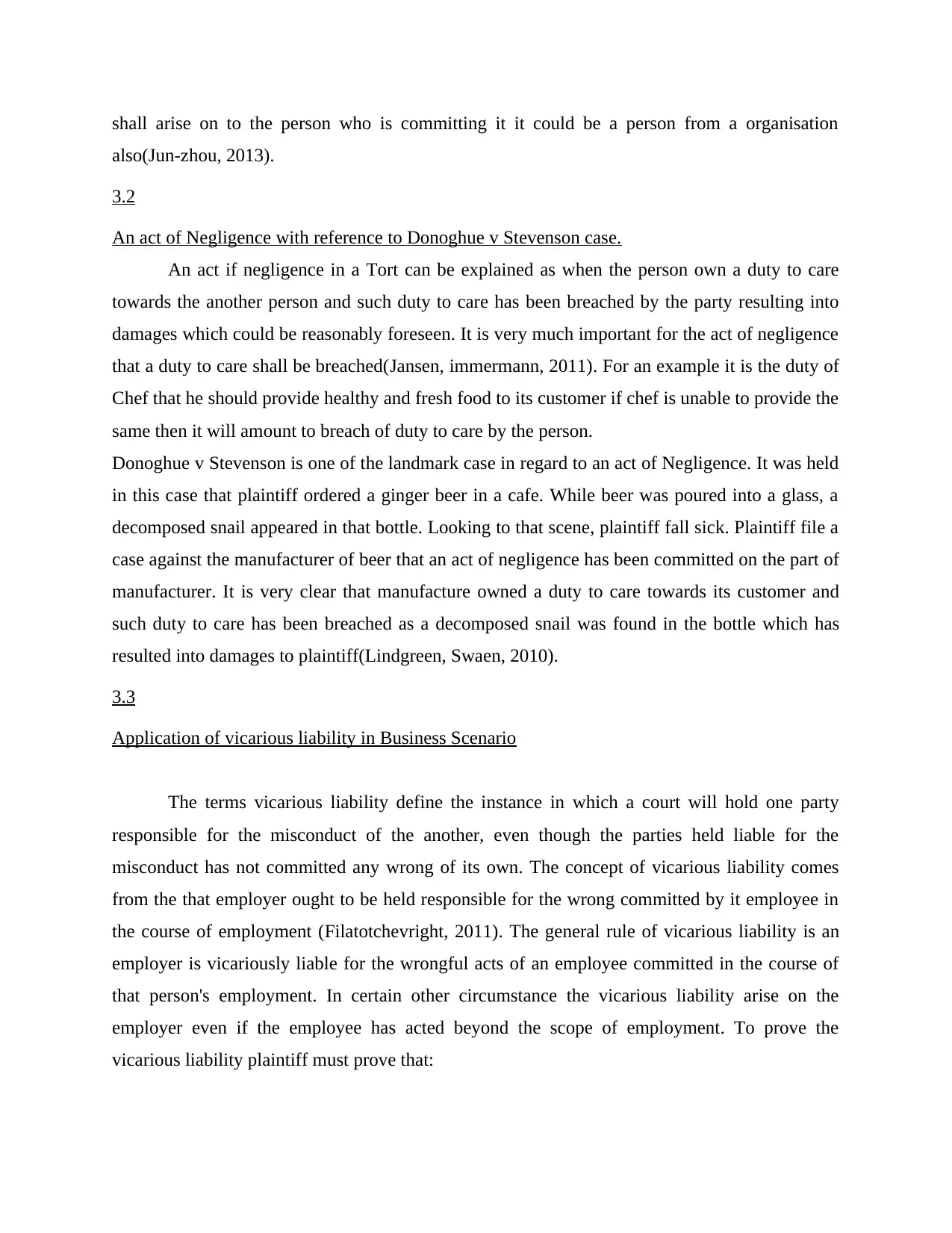
shall arise on to the person who is committing it it could be a person from a organisation
also(Jun-zhou, 2013).
3.2
An act of Negligence with reference to Donoghue v Stevenson case.
An act if negligence in a Tort can be explained as when the person own a duty to care
towards the another person and such duty to care has been breached by the party resulting into
damages which could be reasonably foreseen. It is very much important for the act of negligence
that a duty to care shall be breached(Jansen, immermann, 2011). For an example it is the duty of
Chef that he should provide healthy and fresh food to its customer if chef is unable to provide the
same then it will amount to breach of duty to care by the person.
Donoghue v Stevenson is one of the landmark case in regard to an act of Negligence. It was held
in this case that plaintiff ordered a ginger beer in a cafe. While beer was poured into a glass, a
decomposed snail appeared in that bottle. Looking to that scene, plaintiff fall sick. Plaintiff file a
case against the manufacturer of beer that an act of negligence has been committed on the part of
manufacturer. It is very clear that manufacture owned a duty to care towards its customer and
such duty to care has been breached as a decomposed snail was found in the bottle which has
resulted into damages to plaintiff(Lindgreen, Swaen, 2010).
3.3
Application of vicarious liability in Business Scenario
The terms vicarious liability define the instance in which a court will hold one party
responsible for the misconduct of the another, even though the parties held liable for the
misconduct has not committed any wrong of its own. The concept of vicarious liability comes
from the that employer ought to be held responsible for the wrong committed by it employee in
the course of employment (Filatotchevright, 2011). The general rule of vicarious liability is an
employer is vicariously liable for the wrongful acts of an employee committed in the course of
that person's employment. In certain other circumstance the vicarious liability arise on the
employer even if the employee has acted beyond the scope of employment. To prove the
vicarious liability plaintiff must prove that:
also(Jun-zhou, 2013).
3.2
An act of Negligence with reference to Donoghue v Stevenson case.
An act if negligence in a Tort can be explained as when the person own a duty to care
towards the another person and such duty to care has been breached by the party resulting into
damages which could be reasonably foreseen. It is very much important for the act of negligence
that a duty to care shall be breached(Jansen, immermann, 2011). For an example it is the duty of
Chef that he should provide healthy and fresh food to its customer if chef is unable to provide the
same then it will amount to breach of duty to care by the person.
Donoghue v Stevenson is one of the landmark case in regard to an act of Negligence. It was held
in this case that plaintiff ordered a ginger beer in a cafe. While beer was poured into a glass, a
decomposed snail appeared in that bottle. Looking to that scene, plaintiff fall sick. Plaintiff file a
case against the manufacturer of beer that an act of negligence has been committed on the part of
manufacturer. It is very clear that manufacture owned a duty to care towards its customer and
such duty to care has been breached as a decomposed snail was found in the bottle which has
resulted into damages to plaintiff(Lindgreen, Swaen, 2010).
3.3
Application of vicarious liability in Business Scenario
The terms vicarious liability define the instance in which a court will hold one party
responsible for the misconduct of the another, even though the parties held liable for the
misconduct has not committed any wrong of its own. The concept of vicarious liability comes
from the that employer ought to be held responsible for the wrong committed by it employee in
the course of employment (Filatotchevright, 2011). The general rule of vicarious liability is an
employer is vicariously liable for the wrongful acts of an employee committed in the course of
that person's employment. In certain other circumstance the vicarious liability arise on the
employer even if the employee has acted beyond the scope of employment. To prove the
vicarious liability plaintiff must prove that:
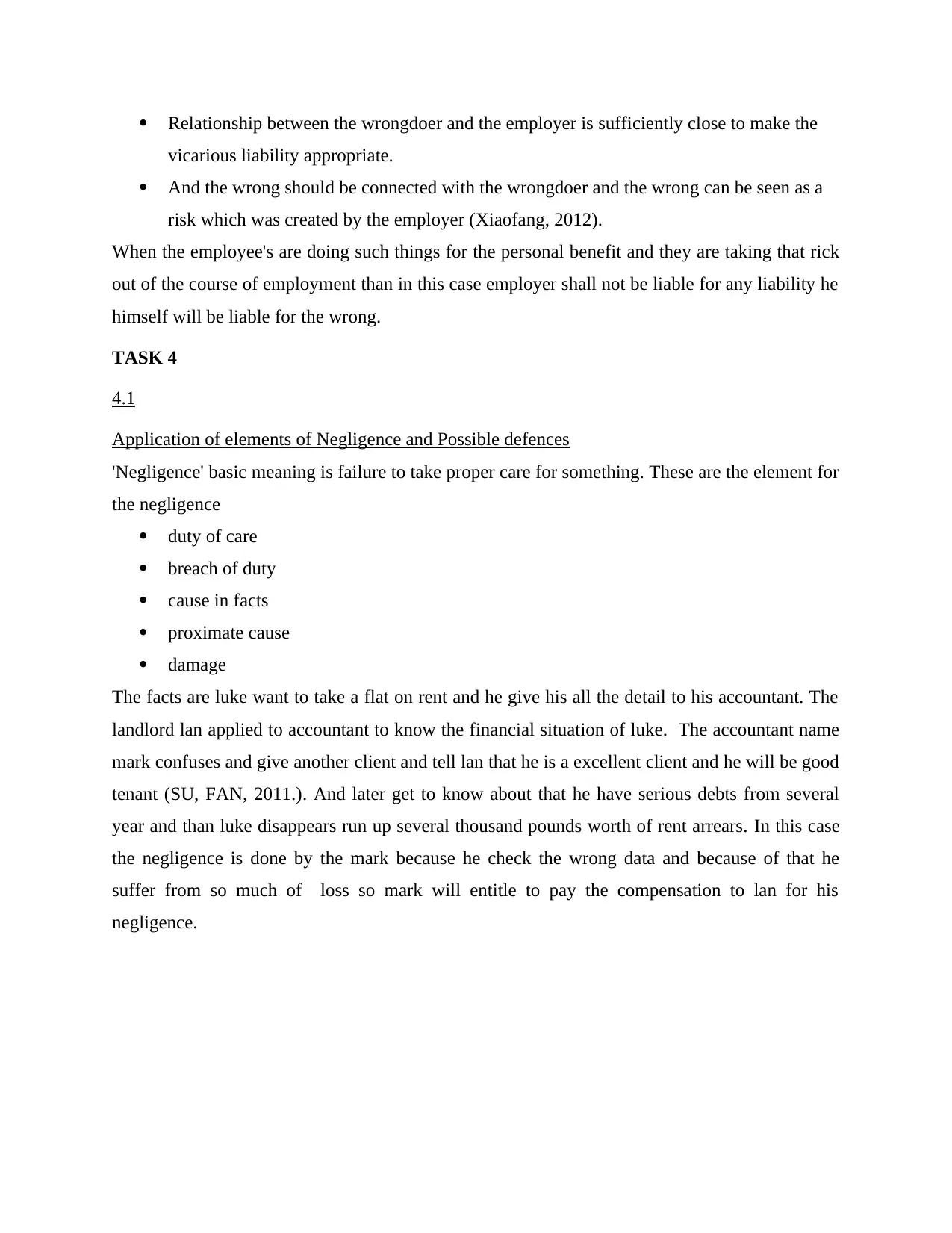
Relationship between the wrongdoer and the employer is sufficiently close to make the
vicarious liability appropriate.
And the wrong should be connected with the wrongdoer and the wrong can be seen as a
risk which was created by the employer (Xiaofang, 2012).
When the employee's are doing such things for the personal benefit and they are taking that rick
out of the course of employment than in this case employer shall not be liable for any liability he
himself will be liable for the wrong.
TASK 4
4.1
Application of elements of Negligence and Possible defences
'Negligence' basic meaning is failure to take proper care for something. These are the element for
the negligence
duty of care
breach of duty
cause in facts
proximate cause
damage
The facts are luke want to take a flat on rent and he give his all the detail to his accountant. The
landlord lan applied to accountant to know the financial situation of luke. The accountant name
mark confuses and give another client and tell lan that he is a excellent client and he will be good
tenant (SU, FAN, 2011.). And later get to know about that he have serious debts from several
year and than luke disappears run up several thousand pounds worth of rent arrears. In this case
the negligence is done by the mark because he check the wrong data and because of that he
suffer from so much of loss so mark will entitle to pay the compensation to lan for his
negligence.
vicarious liability appropriate.
And the wrong should be connected with the wrongdoer and the wrong can be seen as a
risk which was created by the employer (Xiaofang, 2012).
When the employee's are doing such things for the personal benefit and they are taking that rick
out of the course of employment than in this case employer shall not be liable for any liability he
himself will be liable for the wrong.
TASK 4
4.1
Application of elements of Negligence and Possible defences
'Negligence' basic meaning is failure to take proper care for something. These are the element for
the negligence
duty of care
breach of duty
cause in facts
proximate cause
damage
The facts are luke want to take a flat on rent and he give his all the detail to his accountant. The
landlord lan applied to accountant to know the financial situation of luke. The accountant name
mark confuses and give another client and tell lan that he is a excellent client and he will be good
tenant (SU, FAN, 2011.). And later get to know about that he have serious debts from several
year and than luke disappears run up several thousand pounds worth of rent arrears. In this case
the negligence is done by the mark because he check the wrong data and because of that he
suffer from so much of loss so mark will entitle to pay the compensation to lan for his
negligence.
⊘ This is a preview!⊘
Do you want full access?
Subscribe today to unlock all pages.

Trusted by 1+ million students worldwide
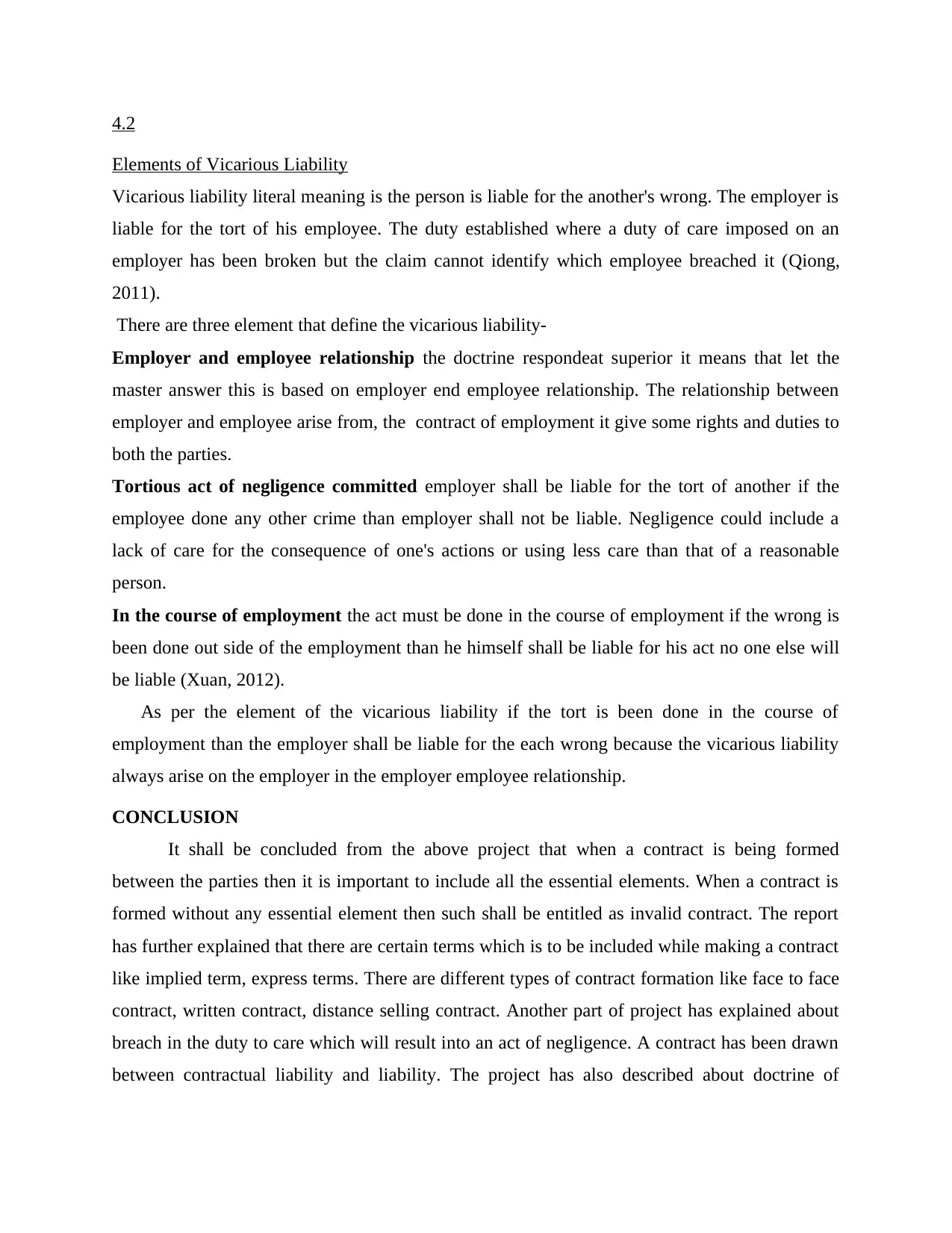
4.2
Elements of Vicarious Liability
Vicarious liability literal meaning is the person is liable for the another's wrong. The employer is
liable for the tort of his employee. The duty established where a duty of care imposed on an
employer has been broken but the claim cannot identify which employee breached it (Qiong,
2011).
There are three element that define the vicarious liability-
Employer and employee relationship the doctrine respondeat superior it means that let the
master answer this is based on employer end employee relationship. The relationship between
employer and employee arise from, the contract of employment it give some rights and duties to
both the parties.
Tortious act of negligence committed employer shall be liable for the tort of another if the
employee done any other crime than employer shall not be liable. Negligence could include a
lack of care for the consequence of one's actions or using less care than that of a reasonable
person.
In the course of employment the act must be done in the course of employment if the wrong is
been done out side of the employment than he himself shall be liable for his act no one else will
be liable (Xuan, 2012).
As per the element of the vicarious liability if the tort is been done in the course of
employment than the employer shall be liable for the each wrong because the vicarious liability
always arise on the employer in the employer employee relationship.
CONCLUSION
It shall be concluded from the above project that when a contract is being formed
between the parties then it is important to include all the essential elements. When a contract is
formed without any essential element then such shall be entitled as invalid contract. The report
has further explained that there are certain terms which is to be included while making a contract
like implied term, express terms. There are different types of contract formation like face to face
contract, written contract, distance selling contract. Another part of project has explained about
breach in the duty to care which will result into an act of negligence. A contract has been drawn
between contractual liability and liability. The project has also described about doctrine of
Elements of Vicarious Liability
Vicarious liability literal meaning is the person is liable for the another's wrong. The employer is
liable for the tort of his employee. The duty established where a duty of care imposed on an
employer has been broken but the claim cannot identify which employee breached it (Qiong,
2011).
There are three element that define the vicarious liability-
Employer and employee relationship the doctrine respondeat superior it means that let the
master answer this is based on employer end employee relationship. The relationship between
employer and employee arise from, the contract of employment it give some rights and duties to
both the parties.
Tortious act of negligence committed employer shall be liable for the tort of another if the
employee done any other crime than employer shall not be liable. Negligence could include a
lack of care for the consequence of one's actions or using less care than that of a reasonable
person.
In the course of employment the act must be done in the course of employment if the wrong is
been done out side of the employment than he himself shall be liable for his act no one else will
be liable (Xuan, 2012).
As per the element of the vicarious liability if the tort is been done in the course of
employment than the employer shall be liable for the each wrong because the vicarious liability
always arise on the employer in the employer employee relationship.
CONCLUSION
It shall be concluded from the above project that when a contract is being formed
between the parties then it is important to include all the essential elements. When a contract is
formed without any essential element then such shall be entitled as invalid contract. The report
has further explained that there are certain terms which is to be included while making a contract
like implied term, express terms. There are different types of contract formation like face to face
contract, written contract, distance selling contract. Another part of project has explained about
breach in the duty to care which will result into an act of negligence. A contract has been drawn
between contractual liability and liability. The project has also described about doctrine of
Paraphrase This Document
Need a fresh take? Get an instant paraphrase of this document with our AI Paraphraser
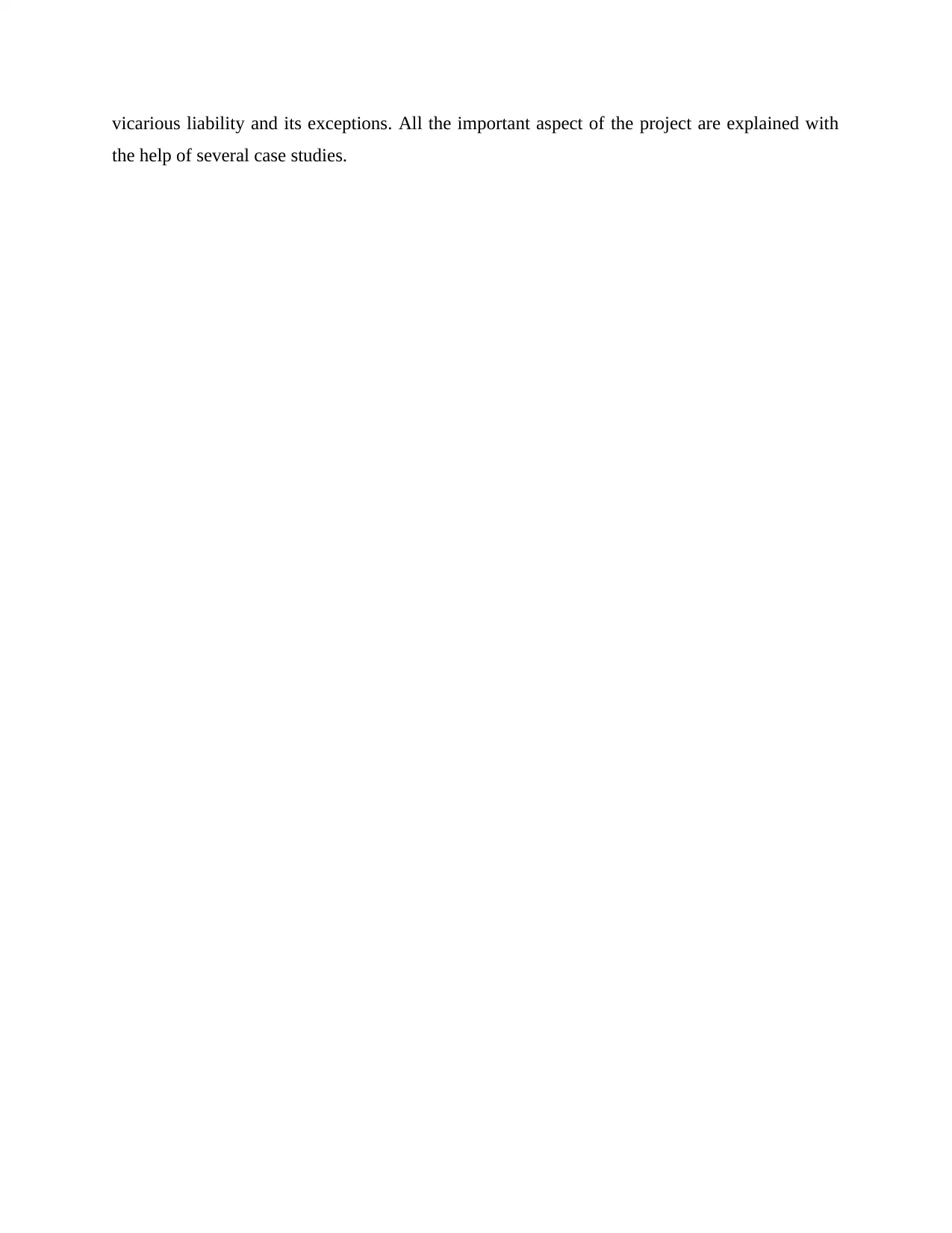
vicarious liability and its exceptions. All the important aspect of the project are explained with
the help of several case studies.
the help of several case studies.
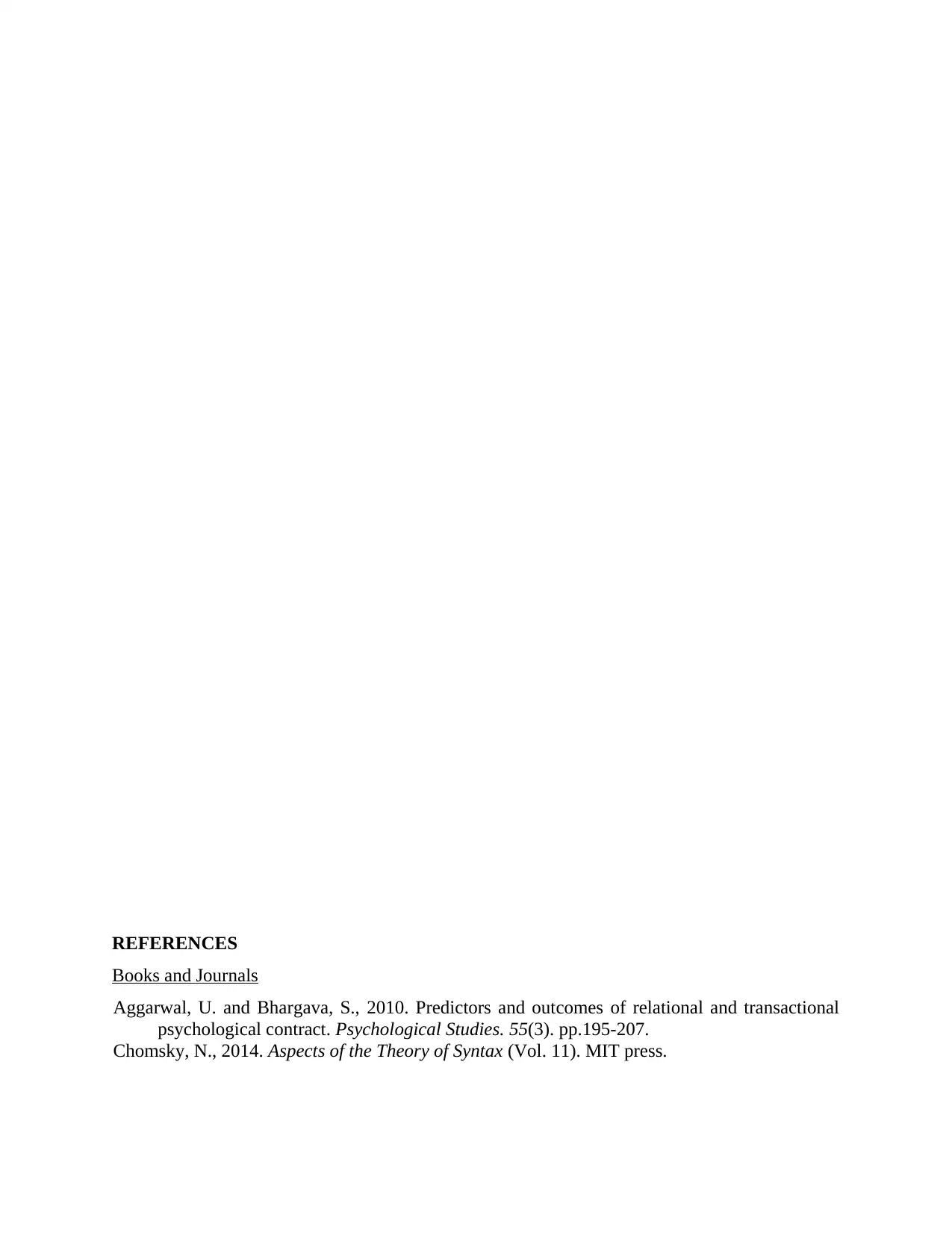
REFERENCES
Books and Journals
Aggarwal, U. and Bhargava, S., 2010. Predictors and outcomes of relational and transactional
psychological contract. Psychological Studies. 55(3). pp.195-207.
Chomsky, N., 2014. Aspects of the Theory of Syntax (Vol. 11). MIT press.
Books and Journals
Aggarwal, U. and Bhargava, S., 2010. Predictors and outcomes of relational and transactional
psychological contract. Psychological Studies. 55(3). pp.195-207.
Chomsky, N., 2014. Aspects of the Theory of Syntax (Vol. 11). MIT press.
⊘ This is a preview!⊘
Do you want full access?
Subscribe today to unlock all pages.

Trusted by 1+ million students worldwide
1 out of 14
Related Documents
Your All-in-One AI-Powered Toolkit for Academic Success.
+13062052269
info@desklib.com
Available 24*7 on WhatsApp / Email
![[object Object]](/_next/static/media/star-bottom.7253800d.svg)
Unlock your academic potential
Copyright © 2020–2025 A2Z Services. All Rights Reserved. Developed and managed by ZUCOL.





